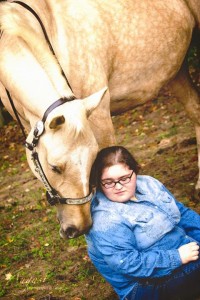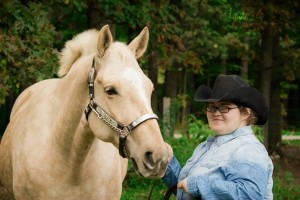How I Found Out My Horse Had PSSM
EC Blog by: Victoria Higgins
I got MysTori on July 22nd, 2007 as an untouched PMU yearling from Canada. She was my very first horse. I taught MysTori everything she knows. In the six years I’ve owned her, MysTori and I have accomplished so much. I’ve taught her dressage, some reining, western pleasure, hunt seat, parades, competitive trail riding, and she has been started on driving. A month after MysTori was broke to ride, she was serving as a therapy horse for disabled and at risk people. She has always had the best temperament a person could ask for. She always has given me 1000%, and she’d do anything I ask of her.
She suffered from almost deadly sand colic when she was 1.5 years old, and I almost lost her. My mother, father, and I nursed her back to health (a process that took what seemed like forever…) Since that point in time, she has always been extremely sensitive and prone to sand colic. As the years went by, I realized that she got anemic off and on, very prone to skin diseases like rain rot, and in general did not have a very good immune system.
Since the first day I got MysTori, I thought she was a little clumsy because she always tripped. She has always been an easy keeper and never did well on any sweetish grain. For the first three to four years of her life, she was just “clumsy.”
When MysTori was about five, I moved her to a new barn. She had grass pasture, grain, and grass hay. She started acting up, and I just thought it was because she was feeling better and no longer had chronic diarrhea from the sand colic. She started having flexing issues and needed more and more chiropractor adjustments.
I moved her again when she was about six. A few months later, she tore her suspensory ligament and digital flexor tendon in her right front leg in a pasture accident. She was off for almost a year. She gained about 200 pounds. She became stubborn and pushy because of the lack of exercise.
I moved her a few months later after her leg injury. She was doing ok but needed to lose a LOT of weight. She was just being fed one cup of grain for her supplements and grass hay. One day, she was eating grass in the arena. When I got there, she couldn’t walk. I thought she was foundering or something. The vet came and pulled blood; she was fine. A few months later, I suspected her of Insulin Resistance. The vet pulled blood; she was fine. By this point, MysTori was “lame” from the loins back. We had selenium tests done; she was fine. This was in April. In October, as a last effort, we finally decided to test her for Polysaccharide storage myopathy, the ONLY thing I could think of that was left to test for, before we brought her to Michigan State University to have her checked out.
On Monday, October 21st, 2013 at around 9 a.m., my worst fears were confirmed. I was right about my diagnosis. My darling, sweet, perfect, best friend was diagnosed with PSSM Type 1 n/P1. When I got the call, I cried my heart out. I cried not only for killed dreams I had for her and I, but for the fact that my dream horse, the horse that has gotten me through so much, has been sick since the day she was born and no one knew.
Everything makes sense now. The soreness, the clumsiness, the “attitude.” No one saw the signs until now. But at least I know I’ve saved her again. We’ve saved each other so many times. I’d give anything to help her become as healthy as possible. She’s my best friend. MysTori is my “once in a lifetime” horse.












